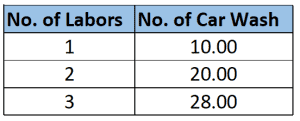When a business owner invests in their firm by hiring new employees, purchasing new equipment, or ordering more raw materials, it isn’t just for amusement. They want to see a return on their investment. They are specifically seeking for increased output, which should potentially boost their company’s net income. The concept of marginal product can be used to show the relationship between increasing investment and increased output.
What is a Marginal Product?
The marginal product formula can be determined by calculating the change in the quantity produced or the change in the level of production and then dividing the same by the change in the factor of production.
For most cases, the denominator is 1 as the formula that was initially formulated was based on an increment of every 1 unit in the production factor. In these situations, companies can only figure out the final output by deducting the previous quantity or level of production from the current level of production.
What is the Marginal Product of Labor?
A marginal labor product is a change in output when additional labor is added, such as when an extra employee is employed. It is important to remember that all the other factors remain constant. In other words, with the marginal product of labor, just the number of labor changes, not any other factor involved in the production.
For example, with our factory manager, if you want to determine the marginal product of labor, you could employ one more worker to see whether additional labor increases the number of cars you can manufacture adequately, or whether it is appropriate to hire more employees to meet your quota.
Calculations of Marginal Product
The marginal product formula is that it equals the change in the total number of units produced divided by the change in a single variable input. For example, assume a factory production line makes 100 toys in an hour and the company adds a new machine to the line.
Now the line produces 500 toys in one hour. The change in the total number of units produced is 400. That’s the difference between the 500 toys the factory production line now makes versus the 100 toys it used to make. This was accomplished by the addition of one machine, so the marginal product is 400 divided by 1, or 400.
Similarly, a restaurant makes 15 sandwiches with four workers. Adding two more people allows the restaurant to make 30 sandwiches. The marginal product is 7.5, or 15 additional sandwiches divided by the two additional employees hired.
Marginal Product Formula
Marginal Product can be identified as an increase in the total production of a factor of production (capital, labor, property, etc.) resulting from an increase of one unit in the factor of production, while other factors of production remain constant. The formula Marginal Product (MP) is shown below:
Marginal Product = (Qn – Qn-1) / (Ln – Ln-1)
- Qn: the Total Production at time n
- Qn-1: the Total Production at time n-1
- Ln: the Units at time n
- Ln-1: the Units at time n-1
Uses of Marginal Product Formula
Calculation of the marginal product allows businesses to see an increase in the number of products produced per unit of labor added. The definition of a single unit of labor can vary by company, but usually, one employee is a single unit of labor.
The goal of the company is to determine the number of employees it must hire in order to achieve maximum production and maximum revenue. Too few employees mean you’re not going to have enough to be productive. So many employees mean you’re going to spend more than you bring in. They are both a concern for any of that company.
How to calculate Marginal Product of labor Example
ABC Company is in the business of washing the cars for their customers. ABC Company wants to hire more labors to grow its business. Following are the details of the output and number of labors:

Therefore, the calculation of marginal product:
- When 2 labors are hired: Marginal Product= (20-10)/(2-1)= 9
- When 3 labors are hired: Marginal Product= (28-20)/(3-2)= 8
Marginal Costs & Revenue
As each new employee is hired, the company incurs increased labor costs, called marginal costs. At the same time, the company is increasing its marginal product. This results in an improvement in revenue called marginal revenue productivity.
When marginal costs and marginal productivity of sales are equal, the company avoids hiring new employees. When the company continues to hire employees after this point, its marginal product and revenue decline as the costs of daily operations increase. Economists refer to this as the law of diminishing returns.
The Law of Diminishing Returns
The Burger restaurant example suggests that each additional worker added to the staff resulted in 7.5 additional sandwiches ready to sell. So theoretically, adding 10 more workers should make 75 more sandwiches available to the restaurant’s customers.
However, the real world seldom follows the theory that closely. Space in the kitchen inside the restaurant might not allow that many additional workers. Perhaps the restaurant can’t procure or set up enough ingredients quickly enough to make all those sandwiches, or any number of other factors can adversely affect how many pizzas are actually produced by more workers.
When additions to marginal product slow and eventually turn negative, economists refer to the event as a diminishing return. More people or more of any production input no longer results in the same spike in output.
What affects marginal product output?
There are several factors that impact the marginal product output. First, there is an increased production element. In the Restaurant example above, the increased production factor was labor.
However, any element of production can be changed and then marginal product measured. Capital, or an increase in funding, is another moveable production factor. Some businesses buy more land or workspace. Machinery is another factor that can affect marginal product output.
The purpose of increasing production is to meet customer demand and eventually increase revenue. Thus, the marginal product output is affected by customer demand. It makes sense for companies to hire more employees or buy more machines to create merchandise if there is a higher demand for the product.
See Also
Net Profit Margin Formula
The Meaning of Interest Rate









